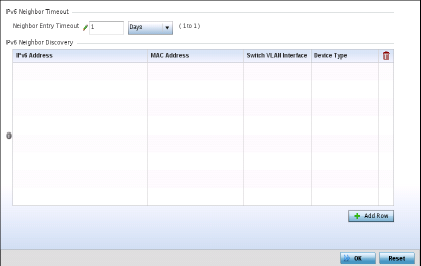IPv6 neighbor discovery uses ICMP messages and solicited multicast addresses to find the link layer address of a neighbor on the same local network, verify the neighbor‘s reachability and track neighboring devices.
At the device level, you can override the device profile's IPv6 neighbor settings. To override the access point Profile's IPv6 neighbor configurations:
The Device Overrides screen displays. This screen lists devices within the managed network.
The selected access point's configuration menu displays.
The IPv6 neighbor configuration screen displays.

|
IPv6 Address |
Provide a static IPv6 IP address for neighbor discovery. IPv6 hosts can configure themselves automatically when connected to an IPv6 network using the Neighbor Discovery Protocol via ICMPv6 (Internet Control Message Protocol version 6) router discovery messages. When first connected to a network, a host sends a link-local router solicitation multicast request for its configuration parameters; routers respond to such a request with a router advertisement packet that contains Internet Layer configuration parameters. IPv6 addresses are composed of eight groups of four hexadecimal digits separated by colons. |
|
MAC Address |
Enter the hardware encoded MAC addresses of up to 256 IPv6 neighbor devices. A neighbor is interpreted as reachable when an acknowledgment is returned indicating packets have been received and processed. If packets are reaching the device, they‘re also reaching the next hop neighbor, providing a confirmation the next hop is reachable. |
|
Switch VLAN Interface |
Use the spinner control to set the virtual interface (from 1 - 4094) used for neighbor advertisements and solicitation messages. |
|
Device Type |
Specify the device type for this neighbor solicitation is for. Options include: Host, Router and DHCP Server. The default setting is Host. |
Select Reset to revert to the last saved configuration.